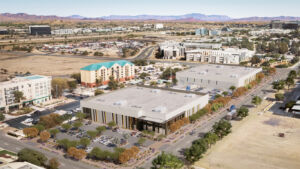On May 17, 2022, Tempe Mayor Corey Woods kicked off AZ Big Media’s inaugural Fueling the Economy event, underscoring the economic growth happening in one of Arizona’s premier cities. During his presentation, Woods touched on just how much the landlocked municipality has developed in recent years and decades, including the center where the event took place.
READ ALSO: Here are 35 commercial real estate projects to know
“[Tempe Marketplace] is an excellent example of how business and government can work together for the benefit of everyone,” Woods explains. “Vestar and the City of Tempe partnered together to annex the land, garner federal grants, remediate the land and build new roads.”
The event included three panels focused on development, hospitality and housing — three vital areas of Tempe’s economy. “I would add a fourth [category]: community,” Woods says. “Development, business, housing and community are all critically linked, and one does not thrive without the others.”

Development panel
Tempe’s ever-changing skyline is a testament to the investments being made in the city. Woods notes that in the last decade, over $3.6 billion of mixed used, commercial and industrial development, with $120 million of that occurring in the first five months of 2022.
That said, the picture isn’t entirely rosy. Lingering complications from the pandemic, such as supply chain issues and labor shortages, are still being felt by the development community.
Charley Freericks, senior vice president at Catellus Development Corporation, notes that he’s been in the business since 1983 and has never seen anything like the current supply shortages for basic building materials. “For example, roofing panel [vendors] — whether it’s for retail or industrial — won’t quote a price. They’ll charge you to get in line, and then when your roofing materials arrive, they’ll set a price for you. It’s really complicated,” he says.
On the labor side, David Krumwiede, senior executive vice present for LPC Desert West, adds that companies are getting creative to deal with lack of workers. “Industrial developers and contractors are doing their own batch plants, which means they’re making concrete on [the construction] site because they can’t find cement truck drivers,” he says.
Hospitality panel
The tourism sector has long been a top industry in Arizona that generates billions of tax dollars for the benefit of the state. The COVID-19 public health crisis, however, took a heavy toll that hospitality businesses are still recovering from.
One trend that Michael Martin, president and CEO of the Tempe Tourism, has encountered are shorter booking windows. Prior to the pandemic, it was common for travelers to book two or three months in advance, but now it’s closer to a week or two — which presents serious challenges.
“How do you plan your staffing if you don’t know how many people are going to be in your hotel the following week?” he asks. “We got to get back to a month or so [booking window] because it helps planning and projections for revenues.”
Other parts of the sector are faring better, according to David Larcher, president and CEO of Vestar. “What’s going on in Tempe Marketplace is a fairly good barometer of not just Tempe, but the entire Valley,” he says. “Our traffic is up almost 20% over 2019 [and] gross sales are up about 18%.”
Housing Panel
Once hailed as an low-cost desert oasis, finding adequate housing in the Valley seems like a mirage to many would-be buyers and renters. This problem is compounded by Tempe’s slim waistline — the municipality is about 40 square miles compared to the City of Mesa’s 138 square miles.
Debra Bradley, COO and CFO of Habitat for Humanity Central Arizona, explains that partnerships with municipalities can help meet housing demand. She describes how Habitat for Humanity turned a 1.01-acre parcel into 18 three-story townhomes with assistance from Tempe to get it through the permitting and zoning processes. “This public-private partnership was very beneficial to the community. There are 17 different countries represented in that development of homeowners.”
Steve Betts, managing director of development for Holualoa Companies, notes that there are great companies addressing the demand for affordable and top-of-market housing, but that still leaves a gap.
“It’s the missing middle piece that we’re struggling with,” he says. “What we’ve been trying to do for several years now is what I refer to as workforce housing by design, so that you can end up with rents that fall within that 80 to 120 [area median income].”
Dwell is an example of one of these projects in Tempe that was kept costs down by taking an existing office project and turning it into mixed use. “That way, you’ve brought down the cost of land because you acquired the office building leased it back to the office users. And then you lose the parking costs by having a shared parking model between office during the day and the apartments at night.”
Want more? Watch the recording of Fueling the Economy here.




